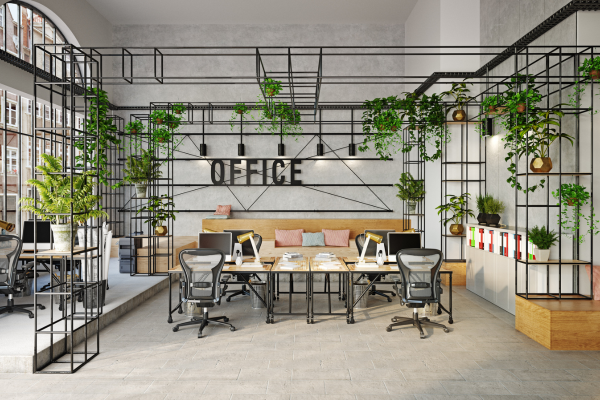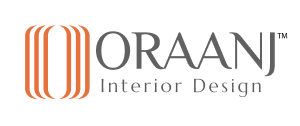“Creativity is putting your imagination to work, and it’s produced the most extraordinary results in human culture.”
– Ken Robinson
Office design has continually evolved, and in 2024, a wave of exciting new trends is expected to reshape the workplace environment. As businesses respond to changing workstyles and priorities, office spaces are transforming. Let’s explore the top 10 modern office design trends for 2024 that will affect how we work, collaborate, and innovate.

1. Flexible Workspaces
Flexibility remains a dominant theme in office design. The post-pandemic world has shown that employees value the ability to choose where and how they work. The flexible workspace is a dynamic office environment that allows for the various working styles and preferences.
These places seek to make work environments more flexible, providing employees with the possibility of choosing their preferred working environment whether it’s a cooperative area for team projects, an open zone for focused tasks or a shared space where they can meet. In order to facilitate the smooth transition of activities, they are often made up of configurable furniture, movable partitions and flexible configurations.
As a result, offices in 2024 will feature more flexible layouts, with modular furniture, adjustable partitions, and versatile meeting spaces that cater to a range of activities and work styles. Flexible workspace promotes employee satisfaction, contributes to organisational productivity and innovation by encouraging a balance of individuals’ efficiency with collective engagement.
2. Hybrid Work Environments
Hybrid work environments combine both remote and in person working positions, which are characterized by flexibility. They provide their staff with an opportunity of working from the office, on a mobile basis, in order for them to make use of both worlds.
These environments shall make it easier to communicate, cooperate and access resources for both on or off site workers by using modern technologies. The use of meeting rooms and working spaces equipped with modern technology to facilitate virtual interaction can be anticipated in these schemes, which will accommodate the needs of staff who work both on site and remotely.
The importance of putting inclusive policies and practices in place to foster a feeling of belonging and engagement between all employees is also highlighted within these environments, promoting equal opportunities for individuals as well as remote workers. Organisations can improve their flexibility and work life balance as well as overall employee satisfaction through the introduction of integrated working environments, which will contribute to improved performance and retention.

3. Biophilic Design
Bringing the outdoors in continues to be a prominent trend. Biophilic design promotes a connection with nature to improve well being and productivity by integrating natural elements and patterns into the built environment. It’s made up of features that make it feel peaceful and harmonious in a work environment, like indoor plants, natural lighting or the use of organic materials into office spaces improve well-being, boost productivity, and reduce stress.
Biophilic design aims to create a more stimulating and refreshed environment by bringing the outdoors into your workplace, ultimately supporting sustainable working conditions for employees. Incorporating natural materials such as wood, stone, or bamboo in the interior design, whether in furniture, flooring, or decorative elements, to establish a connection with the outdoors and evoke a sense of warmth and comfort.
Incorporating sustainable office design practices alongside water elements like indoor fountains, aquariums, or water walls can contribute to a calming and soothing ambience. The integration of sustainable materials, energy-efficient systems, and eco-friendly design principles not only benefits the environment but also enhances employee well-being. The sound and sight of water, in combination with sustainable office design, can have a remarkable effect on reducing stress and promoting a healthier and more eco-conscious workplace.
4. Wellness Centric Centre
The well-being of employees is a top priority. Office designs in 2024 will include wellness-focused amenities such as relaxation zones, meditation rooms, and fitness areas. Natural lighting and ergonomic furniture will also be emphasized to create healthier work environments. In order to support overall health, these spaces may also provide services such as healthy snacks, hydration stations and natural lighting.
In addition, modern office designs may incorporate soundproof rooms for privacy and stress reduction. By offering these wellness-focused environments, organizations aim to nurture a healthier and more balanced work culture, resulting in increased employee satisfaction, reduced stress, and improved overall productivity.
These principles also extend to modern coworking space design, where flexibility and well-being are at the forefront to enhance the collaborative and creative atmosphere in shared workspaces.

5. Sustainable Design
Sustainability has transitioned from being optional to a mandatory consideration in office design. Modern office spaces are increasingly prioritizing the integration of environmentally friendly materials, energy-efficient lighting solutions, and responsible waste management practices. This focus on sustainability is not limited to the broader office design. Still, it extends to the finer details, including creating elegant office cabin design that align with eco-conscious principles, promoting a harmonious blend of aesthetics and sustainability.
Environmentally conscious practices and materials are given priority in sustainable office design so as to minimize the impact on the environment. In this context, it includes the use of renewable energy sources, Energy Efficiency Lighting and Air Conditioning systems as well as integration of Recycled Not Toxic Material in buildings and furniture. Strategies like water conservation, waste elimination and the management of indoor air quality are often included in sustainable designs.
Additionally, you can anticipate a rise in the prevalence of green certifications such as LEED (Leadership in Energy and Environmental Design). The adoption of sustainable design by organizations contributes to a better future and supports healthy environments in the workplace.
6. Remote Work Support
Remote work support entails providing employees with the necessary resources and technology so that they are effective at working from other locations than their traditional office. This will include access to virtual private networks that are protected by VPNs, cloud based collaboration tools and videoconferencing software.
This support encompasses dedicated areas for virtual meetings, improved connectivity, and ergonomic solutions designed to enhance home office arrangements. In addition, organisations may provide allowance for the set up of private offices, ergonomic furniture and computer support on remote technology issues.
In order to keep remote workers in contact and involved with other members of the team, they can also introduce innovative time management policies as well as clearer communication channels. Organisations make it easier for employees to work from home, allowing flexibility, a healthy balance between life and work, and increased productivity.

7. Collaboration Hub
In order to promote creativity and collaboration, office spaces will incorporate collaboration hubs that come equipped with interactive whiteboards, adaptable seating arrangements, and advanced audiovisual technology. These hubs will serve as spaces encouraging impromptu meetings and brainstorming sessions.
It is usually used to support optimal interaction and brainstorming meetings, whether in person or remote, by incorporating the latest digital collaboration tools such as electronic whiteboarding, video conferencing capabilities. Open, inviting plans with comfortable seats and technologically equipped meeting rooms may be made available at this center in order to foster spontaneous discussion and exchange of ideas.
The Centre promotes cross departmental cooperation, idea generation and the formulation of coherent strategies through its support to promote a culture of collaboration and innovation, which in turn contributes to improved problem solving, decision making and organizational performance as a whole.
8. Privacy Pods
In an effort to strike a balance with the open office layout, there will be a growing presence of privacy pods and phone booths. These enclosed areas will be readily available to employees, offering quiet spaces for tasks that require concentration, phone conversations, or video conferences.
Privacy pods are compact, enclosed work spaces which allow employees to have the privacy of a separate area when dealing with specific tasks or private conversations in an office environment. In order to ensure seamless communication and working efficiency, these chambers are usually equipped with sound resistant material, adjustable lighting or combination of technologies.
They provide a quiet and pleasant environment that shields staff from distractions, promotes focus and confidentiality. Privacy pods provide a dedicated work space for focusing on specific activities and sensitivity discussions, which contributes to the balanced office layout, facilitating both cooperation and autonomy of working styles as well as play an important role in promoting employee well being and productivity.

9. Smart Office Technology
The integration of smart technology will continue to grow. Offices will incorporate Iots of devices for space utilization tracking, climate control, and touchless access. Artificial intelligence (AI) will be used to optimize office layouts and improve user experiences. It also encompasses smart security systems, remote access controls, and biometric authentication for enhanced safety and data protection. Organizations can enhance operational efficiency and the employee experience by using such technologies to create more streamlined, secure work environments which are driven by data.
10. Personalisation
Office design will increasingly emphasize the promotion of artistic expression and personalization. Organizations will allocate resources towards the creation of customized art installations, dynamic murals, and individualized workstations, all with the aim of cultivating a distinctive and motivating environment. By prioritizing personalization, organizations create a distinct and inclusive workplace culture that promotes employee satisfaction and loyalty.
As the year progresses, it will become essential to keep a close eye on trends and consider how they might be modified for your particular office needs in order to stay at the forefront of today’s ever evolving workplace design world. In 2024 and beyond, Oraanj Interior Design can help transform your office into a dynamic and inspiring environment that supports the changing needs of your workforce by embracing flexibility, well-being, sustainability, and technology.
Author: Yogita Sawarthia & Gayatri Joshi (Interior Designer)

